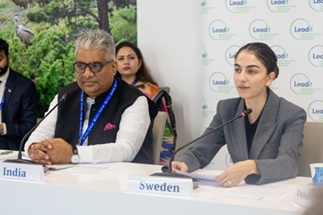(Prelims: Environment, International Organisations + CA)
(Mains: GS 3 – Environment) |
Why in the News ?
The Union Minister for Environment, Forest and Climate Change addressed the Leadership Group for Industry Transition (LeadIT) Industry Leaders’ Roundtable during UNFCCC COP-30 at Belém, Brazil, highlighting India’s commitment to low-carbon industrial transformation.

About Leadership Group for Industry Transition (LeadIT)
Overview
- LeadIT is a global high-level platform promoting the transition of heavy industries to net-zero emissions.
- Launched jointly by India and Sweden at the UN Climate Action Summit 2019.
- Supported by the World Economic Forum (WEF).
- Secretariat: Stockholm Environment Institute (SEI).
- Membership: 18 countries and 27 companies.
Launch & Background
- Established in 2019, recognising that hard-to-abate sectors (steel, cement, transport, chemicals) contribute significantly to global industrial emissions.
- Designed to enable cooperation between governments, industries, and research partners.
LeadIT focuses on:
- Developing low-carbon technology pathways
- Strengthening public-private partnerships
- Enhancing global climate finance flows
- Ensuring just & inclusive industrial transition
Objectives of LeadIT
- Accelerate net-zero industrial transformation.
- Encourage collaboration in:
- Technology co-development
- Policy frameworks
- Financial support mechanisms
- Support emerging economies in adopting low-carbon technologies.
- Promote capacity-building, research exchange, and best-practice sharing.
LeadIT 2.0 (2024–26)
Announced at COP-28 (Dubai).

Focus Areas
- Inclusive & Just Industry Transition
- Co-development & Transfer of Low-Carbon Technology
- Financial Support to Emerging Economies
Mission Statement
Adopted during the LeadIT Summit at COP-28, the three-year mission emphasizes:
- Global cooperation
- Implementation-oriented industrial pathways
- Democratization of clean industrial technologies
Key Initiative: India–Sweden Industry Transition Partnership (ITP)
- Collaboration involves 18 industries and research institutes from both countries.
- Focus sectors:
- Industrial by-product valorisation
- Carbon capture and utilization (CCU)
- AI-based process optimization
- Electrification of industrial systems
- Hydrogen-based industrial heating
India’s Key Highlights at COP-30
- India reiterated its commitment to technology-driven climate leadership.
- Emphasized that global climate governance must shift from goal-setting to implementation.
- India achieved 36% reduction in emission intensity of GDP (2005–2020).
- Announced SKF as a new LeadIT member.
LeadIT Structure
Member Composition Table
|
Component
|
Details
|
|
Founding Countries
|
India & Sweden
|
|
Total Member Countries
|
18
|
|
Industry Members
|
27 global companies
|
|
Secretariat
|
Stockholm Environment Institute
|
|
Supported By
|
World Economic Forum
|
Significance of LeadIT
1. Supports Net-Zero Industrial Goals
Heavy industrial sectors are major emitters; LeadIT helps them shift to low-carbon pathways.
2. Bridges Global Technology Gaps
Encourages joint R&D, tech transfer, and innovation especially for developing nations.
3. Strengthens India’s Climate Leadership
As Co-Chair, India shapes global heavy-industry transition discourse.
4. Drives Green Industrial Competitiveness
Partnerships like ITP boost India’s access to advanced industrial technologies.
5. Facilitates Inclusive Transition
Focuses on emerging economies—ensuring no nation is left behind in the green shift.
Challenges
- High capital requirements for industrial transformation.
- Immature technology ecosystems for hydrogen heating, CCU, etc.
- Limited access to climate finance for developing countries.
- Need for strong monitoring frameworks to ensure compliance.
- Risk of job displacement in traditional industrial sectors.
Way Forward
- Expand blended finance models for industry decarbonization.
- Accelerate pilot projects in steel, cement, and transport sectors.
- Promote skill development & reskilling for workers.
- Enhance global cooperation under LeadIT for faster technology diffusion.
- Encourage more countries and companies to join LeadIT platforms.
|
FAQs
1. What is LeadIT ?
LeadIT is a global initiative launched by India and Sweden to support low-carbon transitions in heavy industries and help achieve net-zero emissions by 2050.
2. When was LeadIT launched ?
It was launched in September 2019 at the UN Climate Action Summit.
3. What is LeadIT 2.0 ?
LeadIT 2.0 (2024–26) is the second phase focusing on just transition, technology co-development, and finance for emerging economies.
4. Who hosts the LeadIT Secretariat ?
The Stockholm Environment Institute (SEI).
5. How does LeadIT benefit India ?
It enhances India’s climate leadership, supports technology access through the India–Sweden partnership, and accelerates decarbonization of heavy industries.
|



